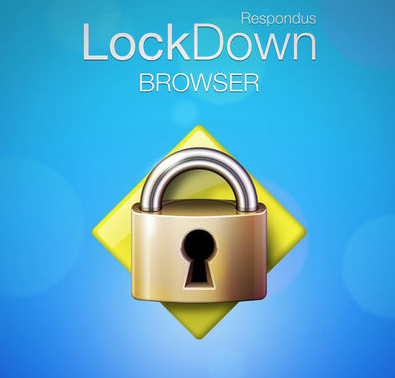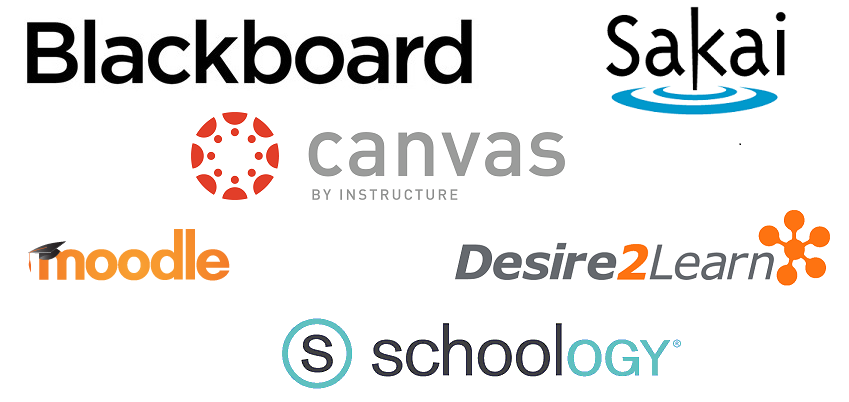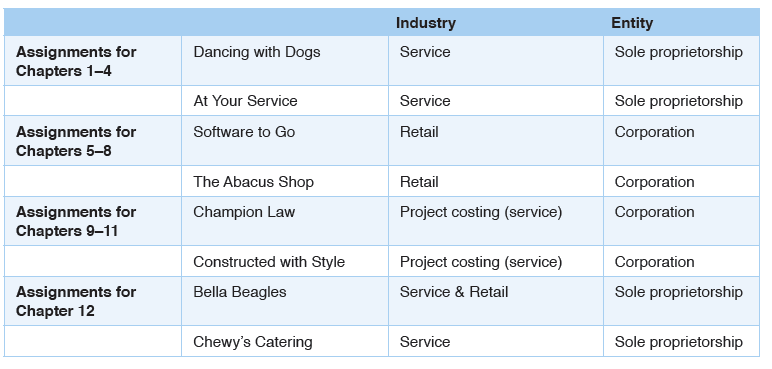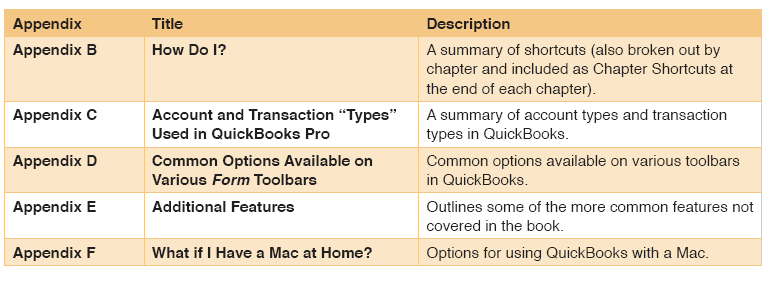Computerized Accounting with QuickBooks Desktop 2018
by Williams
ISBN: 9781618532749 | Copyright 2019
TabsWelcome to Computerized Accounting with QuickBooks 2018.
I wrote this book to give students an introduction to QuickBooks that focuses not only on the software mechanics, but also on the basic accounting concepts that underlie all accounting systems.
This book is not meant to be a user manual. It is meant to teach students how they can work with a computerized accounting system. It is my intention that students will come away from this book with an understanding that it is knowledge of the principles of accounting, not data-entry skills, that are needed to be successful in business.
Target Audience
This book is primarily intended for use in undergraduate accounting programs, although it could be used in business or computer information programs as well. It is expected that students taking this course have already successfully completed a course in financial accounting and have a firm understanding of the principles as well as the mechanics of accounting.
Access to 140-Day Trial Software
Each new copy of this book includes access to a 140-day trial of the QuickBooks 2018 software. Students should refer to the insert at the front of the book, which contains the code and instructions on downloading access to the complimentary software. If you purchase an eBook, please submit a support ticket to receive your code and instructions.
Outstanding Features of This Book
Structure
The book is designed in such a way that the accounting concepts, as well as the software mechanics, get more complex with each section. Other books focus primarily on software data entry. This book allows the students to see why events are recorded the way they are in a computerized accounting system while refreshing students’ knowledge of accounting concepts and reinforcing the accounting and journal entries behind transactions.
Furthermore, rather than treating all company types in one chapter (as most computerized accounting books do), service, merchandising, and project-based companies are broken out separately. This approach helps students learn how the software applications would be implemented in a business environment, so they can practice computerized accounting as they would in the real world.
Clear Writing
The author’s focus on clarity and readability is a cornerstone of the text, and review feedback has been overwhelmingly positive about the quality of the writing and student comprehension. The book is written clearly to aid student understanding of difficult concepts. Clear explanations of why certain procedures are used in QuickBooks are supported by relevant examples and relatable end-of-chapter assignments, serving to bridge the gap between computerized accounting concepts and real-world application.
Real-World Scenarios
Most computerized accounting textbooks on the market approach the teaching of QuickBooks in a prescriptive manner, going through the procedures of the software while overlooking how an accountant would actually utilize the software in the real world. Williams’ Computerized Accounting takes a practical approach and shows the student how the software is used in a business environment. In addition to the standard financial reports, students are exposed to job (project) costing, segment, and variance reports.
Unique Pedagogy
The book’s four-color format facilitates student understanding and draws attention to the key concepts and pedagogy. Ample screenshots provide students realistic snapshots of what they will see when working in the software. A host of pedagogical elements serve as helpful illustrations, providing additional context and further concept reinforcement.
HINT Boxes
Hint boxes appear throughout to provide helpful quick tips and tricks for how to work in Quickbooks.
WARNING Boxes
WARNING boxes highlight common pitfalls to avoid.
BEHIND THE SCENES Boxes
BEHIND THE SCENES boxes provide additional context in support of the accounting that is going on inside the computer.
QuickChecks
When students are learning accounting application software, it’s natural for them to focus on the software mechanics and forget that they’re taking an accounting course. To help put some of their focus back on accounting, students are periodically asked a question related to material covered in the chapter. The questions are intended to remind them, either directly or indirectly, of underlying accounting concepts. The answers are included at the end of each chapter.
Key Terms
Appearing in red, bold font in the first instance, key terms are defined for the student in the margins of the text for a quick refresher. A comprehensive glossary is included in the back of the book.
Practice Exercises
Practice Exercises are included at the end of every section in the first ten chapters. The exercises provide students an immediate opportunity to practice the material they just learned and prepare them for completing the chapter assignments. The exercises use a fictional but realistic company that provides accounting services to small business clients. The Practice Exercises can be done in class, with the instructor, as part of the lecture component of the course or can be done by the students, on their own, as part of the lab component of the course. Check figures are included with the exercises to reassure students that they are recording the transactions accurately.
End of Chapter Material
End-of-chapter review material includes:
- Chapter shortcuts
- Chapter review with matching of terms to definitions and multiple choice questions that are a combination of accounting concepts and QuickBooks application questions.
- End-of-chapter assignments featuring realistic companies. Two sets of assignments are included per chapter, allowing the instructor the ability to change the material assigned to various course sections.
The assignments include check numbers for students. This allows them to focus on the process and reduces student frustration.
End-of-Book Assignment
An optional assignment is provided at the end of the book that instructors can assign as an extra credit assignment. It includes two separate assignments requiring students to identify and correct errors in realistic sets of company files.
Appendices
There are a number of additional topics that are helpful to students as they master QuickBooks, and these have been included as end-of-chapter and end-of-book appendices. Instructors may wish to cover these topics in class or have students go over on their own time. End-of-chapter appendices on special topics include:

Students often have a difficult time seeing any similarities between computerized accounting systems and the more manual systems they saw in their introductory financial accounting classes (the journal entries, T-accounts, and general ledgers). To help students connect the two, Appendix A (Is Computerized Accounting Really the Same as Manual Accounting?) is an accounting refresher that compares manual and computerized accounting and provides examples of how journal entries, journals, T-accounts, and trial balances show up in QuickBooks. It also covers cash versus accrual accounting. Other end-of-book appendices review accounting principles and mechanics, including:
Certiport-Mapped
The book has been reviewed by Certiport and maps to the 10 domains that comprise the exam objectives for the QuickBooks Certified User Exam.
What Is the QuickBooks Certified User Exam?
The Intuit® QuickBooks Certification exam is an online exam that is proctored at Certiport Authorized Testing Centers. The certification program validates QuickBooks accounting skills while providing students with credentials that demonstrate real-world abilities to prospective employers. Once passed, test takers receive an official digital certificate representing their skills in QuickBooks. The author has prepared a map correlating the chapter content to the Certiport domains. See preface page x.
Structure
The book is designed in such a way that the accounting concepts, as well as the software mechanics, get more complex with each section. Other books focus primarily on software data entry. This book allows the students to see why events are recorded the way they are in a computerized accounting system while refreshing students’ knowledge of accounting concepts and reinforcing the accounting and journal entries behind transactions. Furthermore, rather than treating all company types in one chapter (as most computerized accounting books do), service, merchandising, and project-based companies are broken out separately. This approach helps students learn how the software applications would be implemented in a business environment, so they can practice computerized accounting as they would in the real world.
- Section One—Introduction
- The first chapter introduces students to the basic structure of QuickBooks 2018.
- File types
- Lists
- Navigational tools
- Preferences
- The first chapter introduces students to the basic structure of QuickBooks 2018.
- Section Two—Service Companies
- The next three chapters (Chapters 2, 3, and 4) cover the sales, purchase, and end-of-month cycles in a service company.
- Students are introduced to accounting for basic accounting transactions in a computerized environment.
- Sales on account and cash sales
- Purchases on account and cash purchases
- Customer collections and vendor payments
- Bank reconciliations
- Standard end-of-month adjusting entries
- Financial statement reporting
- Section Three—Merchandising Companies
- The section introduction includes a description of internal controls in QuickBooks.
- Chapters 5, 6, and 7 cover the sales, purchase, and end-of-month cycles in a merchandising company.
- Students are introduced to accounting for more complex transactions in a computerized environment.
- Purchase and sale of inventory
- Sales tax
- Sales and purchase discounts
- Inventory tracking, adjustment, and valuation
- Sales of equipment
- Bad debts and bounced checks
- Section Four—Payroll, Project Costing, and Billing for Time
- Chapter 8 covers basic payroll functions that would be used in all types of companies (service, merchandising, and manufacturing).
- Compensation (salaried and hourly)
- Paycheck creation
- Payroll taxes (withholding and remittance)
- Chapter 9 covers job costing and billing for time.
- Tracking time
- Billing for time and expense
- Tracking and reporting profitability by project
- Chapter 8 covers basic payroll functions that would be used in all types of companies (service, merchandising, and manufacturing).
- Section Five—Beyond the Basics
- Chapter 10 covers budgeting and segment reporting.
- Creating budgets
- Budget variance reports
- Use class tracking to report on business segments
- Chapter 11 covers a number of special tools in QuickBooks
- Memorizing reports and transactions
- Customization of forms
- Custom reporting
- Exporting reports to Excel
- Creating reversing entries
- Chapter 12 covers the initial set up of companies in QuickBooks and the conversion of existing companies to QuickBooks.
- Chapter 13 provides an overview of QuickBooks Online.
- Chapter 10 covers budgeting and segment reporting.
For Instructors
• Solutions Manual files prepared by the author contain solutions to all the assignment material.
• QuickBooks backup files for each assignment are available.
• PowerPoint presentations illustrate chapter concepts and outline key elements with corresponding screenshots for each chapter.
• Test Bank questions written by the author includes true/false and multiple-choice questions for each chapter.
• Two Midterm and Two Final Exams prepared by the author are provided and are designed to test students’ understanding of the fundamentals of accounting and the mechanics of computerized accounting in a small service business. The midterm exam covers the material included in Chapters 1 through 4. One of the final exams covers the material included in Chapters 1 through 8. The other final exam covers the material included in Chapters 1 through 10. The exams are to be completed using QuickBooks and can be completed in a two-hour class session
• Extra Credit project suggestions
• myBusinessCourse: A web-based learning and assessment program intended to complement your textbook and classroom instruction (see separate tab). This easy-to-use course management system includes question banks comprised of practice exercises, test bank questions, and assignment questions related to the end-of-chapter content that can be graded automatically. eLecture videos created and narrated by the author are also available (see below for list). myBusiness Course provides students with additional help when you are not available.
For Students
• Access to 140-day trial of QuickBooks 2018 Premier software with purchase of each new copy of the book.
• myBusinessCourse: (See separate tab about features.) A web-based learning and assessment program intended to complement your textbook and faculty instruction. This easy-to-use program grades assignments automatically and provides you with additional help when your instructor is not available. Access is free with new copies of this textbook (look for the page containing the access code towards the front of the book).
• eLecture Presentations created and narrated by the author and available in myBusinessCourse cover essential topics and procedures in QuickBooks, including:
■ Creating, opening, and backing up files
■ Setting up accounts
■ Setting up customers
■ Recording sales and customer payments
■ Setting up vendors
■ Setting up employees
■ Setting up payroll items
■ Setting up items (one for service, one for product)
■ Recording purchases and vendor payments Using Timesheets
■ Paying employees
■ Setting up 1099 vendor tracking
■ Reconciling bank and credit card accounts
■ Preferences in QuickBooks
■ Financial statement presentation hints
■ Customizing reports
■ Finding errors in company files
• QuickBooks Student data files (as .QBB files) are available for download from the book’s website.
• Check Figures are included for assignments, allowing students to focus on the process and reduce frustration.
Introducing myBusinessCourse
myBusinessCourse is a complete, secure, web-based training and e-Learning solution. There is nothing to download or install; it is accessible through any modern web browser and most mobile devices.

eLecture Videos
- Created by the authors of the textbook
- Consistent with the textbook's explanations and approach
- Cover learning objectives and concepts from each chapter
- Ideal for remediation
- Ideal for online and hybrid classrooms

Guided Example Videos
- Created by the authors of the textbook
- Provide problem solving strategies as well as solutions
- Offer clear, step-by-step demonstrations of how to solve select problems from the textbook

Auto-graded Assignments
- Provides immediate feedback
- Create assignments using problems from the textbook
- Additional randomized versions of assignments provide extra practice
- Ideal for remediation
- Include select questions from test banks

Respondus LockDown Browser®
- Assessments are displayed full-screen and cannot be minimized
- Browser menu and toolbar options are removed, except for Back, Forward, Refresh and Stop
- Prevents access to other applications including messaging, screen-sharing, virtual machines, and remote desktops
- Printing and screen capture functions are disabled
- Copying and pasting anything to or from an assessment are prevented
- Right-click menu options, function keys, keyboard shortcuts and task switching are disabled
- An assessment cannot be exited until the student submits it for grading
- Assessments set up with LockDown Browser cannot be accessed with other browsers
- Students use their preferred device to take exams (iPad, Mac, Windows)
- Students will be prompted to install LockDown Browser prior to accessing the exam

Detailed Reporting Tools
- Quickly review the performance of individual students
- Quickly review the performance of entire class
- Use reports on student performance to customize your lectures to fit student needs
Enhanced eBook
- Save money
- Includes myBusinessCourse
- Integrates eLecture and demonstration videos
- Bookmarking
- Note taking
- Highlighting

Third Party Integrations
- Single sign-on
- Link to assignments in myBusinessCourse from your third party course
- Automatically sync gradebooks each night
Flashcards
- Study, learn and master key terms.
- With linear-mode, get full control over the deck. Go back and forth between cards, shuffle and auto-play the deck.
- With certainty-mode, test how well you know each term. If you are not certain you have learned the term, it will display again later in the deck.

Support and Training
- Technical support for students and faculty available daily
- Faculty training conducted daily
| Expand/Collapse All | |
|---|---|
| About the Author (pg. iii) | |
| Preface (pg. iv) | |
| Brief Table of Contents (pg. xvi) | |
| Section One: Introduction (pg. 1) | |
| What Is “Computerized Accounting”? (pg. 1) | |
| Section Overview (pg. 2) | |
| Chapter 1: Introduction to QuickBooks Pro (pg. 3) | |
| QuickBooks Pro (pg. 4) | |
| Before We Go Any Further (pg. 5) | |
| Installing And Updating Quickbooks Pro (pg. 5) | |
| Updating the Program (pg. 6) | |
| Practice (pg. 7) | |
| Working With Company Files (pg. 8) | |
| Creating and Opening Working Files (pg. 9) | |
| Backing Up Files (pg. 12) | |
| Restoring Backup Files to an Existing Working File (pg. 14) | |
| Moving Around in QuickBooks Pro (pg. 17) | |
| Accessing Tools (pg. 17) | |
| Finding Transactions (pg. 21) | |
| Open Windows (pg. 23) | |
| Quickbooks Pro Organization (pg. 24) | |
| The Importance of “Lists” (pg. 24) | |
| Chart of Accounts (pg. 24) | |
| Adding, Editing, or Deleting Accounts (pg. 25) | |
| Other Lists in Quickbooks (pg. 30) | |
| Editing an Item (pg. 30) | |
| Behind the Scenes with Transaction Types (pg. 32) | |
| Reporting (pg. 34) | |
| Report Modification (pg. 34) | |
| Customizing Quickbooks Pro (pg. 38) | |
| Editing Preferences (pg. 39) | |
| Customizing the Look of Quickbooks (pg. 39) | |
| Customizing the Icon Bar (My Shortcuts Tab) (pg. 40) | |
| A Few General Guidelines (pg. 41) | |
| Messages (pg. 41) | |
| When You Make Mistakes (pg. 42) | |
| Suggestions for Finding Mistakes (pg. 42) | |
| When You’re Done For The Day (pg. 43) | |
| Chapter Shortcuts (pg. 44) | |
| Chapter Review (Answers available on the publisher’s website.) (pg. 45) | |
| Assignments (pg. 46) | |
| Appendix 1A Multi-User Mode (pg. 52) | |
| Initial Configuration (pg. 53) | |
| Working In Multi-User Mode (pg. 54) | |
| Appendix 1B CHANGING PASSWORD MANAGEMENT SETTINGS (pg. 55) | |
| Section Two: Service Companies (pg. 57) | |
| Section Overview (pg. 57) | |
| Chapter 2: Selling Services (Service Company) (pg. 59) | |
| What Is The Sales Cycle In A Service Company? (pg. 60) | |
| Managing Customers (pg. 60) | |
| Adding a Customer (pg. 60) | |
| Changing a Customer Record (pg. 63) | |
| Managing Service Items (pg. 64) | |
| Adding a Service Item (pg. 65) | |
| Editing and Deleting Items (pg. 66) | |
| Recording Sales Revenue (pg. 67) | |
| Recording Sales on Account (pg. 68) | |
| Recording Cash Sales (pg. 70) | |
| Recording Customer Credits (pg. 72) | |
| Recording Payments From Customers (pg. 75) | |
| Payments on Account (pg. 75) | |
| Making Deposits (pg. 78) | |
| Customer Reports (pg. 80) | |
| Chapter Shortcuts (pg. 82) | |
| Chapter Review (pg. 82) | |
| Assignments (pg. 83) | |
| Chapter 3: Incurring Costs (Service Company) (pg. 91) | |
| What Is The Purchase Cycle In A Service Company? (pg. 92) | |
| Managing Vendors (pg. 92) | |
| Adding a Vendor (pg. 93) | |
| Setting Up 1099 Vendors (pg. 95) | |
| Changing Vendor Information and Deleting Vendors (pg. 98) | |
| Recording Purchases (pg. 100) | |
| Purchasing on Account (pg. 100) | |
| Creating a New Credit Term (pg. 102) | |
| Purchasing with Cash, Check, or Debit Card (pg. 104) | |
| Voiding Checks (pg. 106) | |
| Purchasing with a Credit Card (pg. 107) | |
| Paying Vendor Balances (pg. 109) | |
| Vendor Reports (pg. 112) | |
| Chapter Shortcuts (pg. 113) | |
| Chapter Review (pg. 114) | |
| Assignments (pg. 115) | |
| Chapter 4: End-of-Period Procedures (Service Company) (pg. 121) | |
| Before Issuing Financial Statements (pg. 122) | |
| Bank Reconciliations (pg. 123) | |
| Fixing Bank Reconciliation Errors (pg. 126) | |
| Credit Card Reconciliations (pg. 127) | |
| Making Adjusting Journal Entries (pg. 129) | |
| Closing A Period (pg. 132) | |
| Closing an Accounting Period (pg. 132) | |
| Year-End Closing (pg. 134) | |
| Special Considerations for Partnerships (pg. 135) | |
| Preparing Financial Statements (pg. 135) | |
| Chapter Shortcuts (pg. 138) | |
| Chapter Review (pg. 138) | |
| Assignments (pg. 139) | |
| Appendix 4A Getting It Right (pg. 145) | |
| Section Three: Merchandising Companies (pg. 149) | |
| Controls in QuickBooks (pg. 149) | |
| Limiting User Access (pg. 149) | |
| Editing Users (pg. 153) | |
| Reporting On Transaction History (pg. 153) | |
| Section Overview (pg. 154) | |
| Chapter 5: Selling Products (Merchandising Company) (pg. 155) | |
| What Is the Sales Cycle in a Merchandising Company? (pg. 156) | |
| Managing Customers (pg. 156) | |
| Customers and Sales Tax (pg. 156) | |
| Shipping Addresses (pg. 159) | |
| Managing Items (Merchandising Company) (pg. 161) | |
| Setting Up Inventory Items (pg. 162) | |
| Recording Sales Revenue (pg. 166) | |
| Customer Discount and Subtotal Items (pg. 166) | |
| Recording Uncollectible Accounts (pg. 168) | |
| Recording Payments From Customers (pg. 171) | |
| Customer Payments by Credit Card (pg. 171) | |
| Customer Checks Returned by Bank Due to Insufficient Funds (NSF Checks) (pg. 175) | |
| Early Payment Discounts (pg. 179) | |
| Customer Reports (pg. 182) | |
| Customer Statements (pg. 183) | |
| Chapter Shortcuts (pg. 184) | |
| Chapter Review (pg. 184) | |
| Assignments (pg. 185) | |
| Chapter 6: Incurring Costs (Merchandising Company) (pg. 199) | |
| What Is The Purchase Cycle In A Merchandising Company? (pg. 200) | |
| Managing Vendors (pg. 200) | |
| Purchasing Inventory (pg. 201) | |
| Paying at Time of Inventory Purchase (pg. 202) | |
| Ordering Inventory (pg. 203) | |
| Managing Purchase Orders (pg. 214) | |
| Ordering Inventory without Using the Purchase Order System (pg. 216) | |
| Vendor Credits (pg. 216) | |
| Special Considerations for Returns of Inventory (pg. 218) | |
| Paying Vendor Balances (pg. 219) | |
| Vendor Reports (pg. 223) | |
| Chapter Shortcuts (pg. 224) | |
| Chapter Review (pg. 224) | |
| Assignments (pg. 225) | |
| Chapter 7: End-of-Period Procedures (Merchandising Company) (pg. 235) | |
| Adjusting Inventory (pg. 236) | |
| Managing Sales Taxes (pg. 240) | |
| Entering Cash Receipts Not Related To Normal Sales Transactions (pg. 244) | |
| Recording Bank Transfers (pg. 247) | |
| Inactivating and Merging General Ledger Accounts (pg. 249) | |
| Inactivating an Account (pg. 249) | |
| Merging Accounts (pg. 250) | |
| Adding Comments To Reports (pg. 252) | |
| Verifying Data (pg. 254) | |
| Chapter Shortcuts (pg. 256) | |
| Chapter Review (pg. 256) | |
| Assignments (pg. 257) | |
| Appendix 7A Optional Year-End Closing Process (pg. 265) | |
| Section Four: Payroll, Project Costing, and Billing for Time (pg. 271) | |
| Section Overview (pg. 271) | |
| Before We Move Forward (pg. 272) | |
| Compensation (pg. 272) | |
| Payroll Taxes (pg. 272) | |
| Benefits (pg. 272) | |
| Chapter 8: Paying Employees (pg. 273) | |
| What Is The Payroll Cycle? (pg. 274) | |
| Payroll Plans Available In Quickbooks (pg. 274) | |
| Turning On Manual Payroll Processing (pg. 275) | |
| Managing Payroll Items (pg. 279) | |
| Hourly Wage Setup (pg. 281) | |
| Annual Salary Setup (pg. 285) | |
| Editing Payroll Items (pg. 287) | |
| Special Considerations: Federal and State Payroll Taxes (pg. 287) | |
| Managing Employees (pg. 290) | |
| New Employee Setup (pg. 290) | |
| Editing Employees (pg. 295) | |
| Processing Payroll (pg. 297) | |
| Creating Paychecks (pg. 297) | |
| Editing Paychecks (pg. 303) | |
| Processing And Reporting Payroll Taxes (pg. 305) | |
| Remitting (Depositing) Payroll Taxes (pg. 306) | |
| Editing Payroll Tax Liabilities (pg. 308) | |
| Preparing Payroll Tax Forms (pg. 308) | |
| Preparing Payroll Reports (pg. 308) | |
| Chapter Shortcuts (pg. 309) | |
| Chapter Review (pg. 310) | |
| Assignments (pg. 311) | |
| Appendix 8A Tracking Employee Sick And Vacation Time (pg. 317) | |
| Setting Up Payroll Items For Leave Time (pg. 317) | |
| Setting Up Sick and Vacation Leave in Employee Records (pg. 319) | |
| Recording Sick And Vacation Leave Taken (pg. 321) | |
| Leave Time Reporting (pg. 322) | |
| Chapter 9: Project Costing and Billing for Time and Expense (pg. 325) | |
| Setting up Jobs (pg. 326) | |
| Using Timesheets (pg. 329) | |
| Turning On Time Tracking (pg. 330) | |
| Entering Timesheet Data (pg. 332) | |
| Processing Payroll Using Timesheet Data (pg. 335) | |
| Verifying Hours (pg. 335) | |
| Creating Paychecks Using Time Data (pg. 337) | |
| Billing for Time and Costs (pg. 340) | |
| Identifying Billable Costs Other Than Labor (pg. 340) | |
| Adding Billable Time And Expenses To A Sales Form (pg. 341) | |
| Preparing Job Reports (pg. 345) | |
| Chapter Shortcuts (pg. 346) | |
| Chapter Review (pg. 347) | |
| Assignments (pg. 348) | |
| Section Five: Beyond the Basics (pg. 369) | |
| Section Overview (pg. 369) | |
| Chapter 10: Management Tools (pg. 371) | |
| Tracking By Class (pg. 372) | |
| Turning On Class Tracking (pg. 373) | |
| Setting Up Classes (pg. 375) | |
| Assigning Classes To Transactions (pg. 376) | |
| Reporting By Class (pg. 380) | |
| Creating and Using Budgets (pg. 382) | |
| Creating Budgets (pg. 383) | |
| Manual Method of Entering Budget Amounts (pg. 385) | |
| Copy Across Method of Entering Budget Amounts (pg. 385) | |
| Trend Method of Entering Budget Amounts (pg. 385) | |
| Creating Budget Reports (pg. 388) | |
| Chapter Shortcuts (pg. 389) | |
| Chapter Review (pg. 389) | |
| Assignments (pg. 391) | |
| Chapter 11: Additional Tools (pg. 405) | |
| Reversing Entries (pg. 406) | |
| Memorizing Transactions (pg. 408) | |
| Memorizing Reports (pg. 410) | |
| Memorizing A Report (pg. 410) | |
| Creating A Memorized Report Group (pg. 411) | |
| Processing Multiple Reports (pg. 411) | |
| Customizing Forms (pg. 413) | |
| Template Changes On The Initial (Basic Customization) Screen (pg. 415) | |
| Template Changes On The Additional Customization Screen (pg. 416) | |
| Template Changes In The Layout Designer Screen (pg. 417) | |
| Exporting Reports To Excel (pg. 421) | |
| Chapter Shortcuts (pg. 425) | |
| Chapter Review (pg. 425) | |
| Assignments (pg. 426) | |
| Appendix 11A Using Custom Fields (pg. 429) | |
| Appendix 11B Using The Report Center (pg. 433) | |
| Chapter 12: Setting Up a Company in QuickBooks (pg. 437) | |
| Setting Up A New Company File (pg. 438) | |
| Additional Steps When Converting An Existing Company To Quickbooks (pg. 446) | |
| Entering Information About Existing Customers (pg. 446) | |
| Entering Information About Existing Vendors (pg. 448) | |
| Entering Information About Existing Items (pg. 450) | |
| Entering Information About Existing Employees And Current Payroll Structure (pg. 452) | |
| Entering Information About Other Existing Accounts (pg. 464) | |
| Summary Of Steps When Setting Up A Quickbooks File For An Existing Company (pg. 465) | |
| Chapter Shortcuts (pg. 466) | |
| Chapter Review (pg. 467) | |
| Assignments (pg. 468) | |
| Chapter 13: QuickBooks Online (pg. 473) | |
| Comparison of QuickBooks Online Plus to QuickBooks Premier (pg. 474) | |
| A Brief Look At Quickbooks Online (pg. 476) | |
| EC: Optional Extra Credit Assignments (pg. 481) | |
| Opportunity 1: Language Tutoring Services (pg. 481) | |
| Opportunity 2: Safe At Home (pg. 482) | |
| Appendix A: Is Computerized Accounting Really the Same as Manual Accounting? (pg. 485) | |
| Accrual And Cash Basis Accounting In Quickbooks (pg. 487) | |
| Comparison Of Computerized And Manual Accounting Systems (pg. 487) | |
| Journal Entries (pg. 487) | |
| Journals (pg. 488) | |
| General Ledger and T-Accounts (pg. 490) | |
| Trial Balances (pg. 492) | |
| Appendix B: How Do I? (pg. 495) | |
| How Do I? (General) (pg. 495) | |
| Manage Company Files (pg. 495) | |
| Customize My Company File (pg. 496) | |
| How Do I? (Manage Lists) (pg. 496) | |
| Manage Chart Of Accounts (pg. 496) | |
| Manage Customer Records (pg. 497) | |
| Manage Vendor Records (pg. 497) | |
| Manage Employee Records (pg. 498) | |
| Manage Item Records (pg. 498) | |
| Manage Payroll Item Records (pg. 498) | |
| How Do I? (Record Transactions) (pg. 499) | |
| Record Sales Activity (pg. 499) | |
| Record Purchase Activity (pg. 499) | |
| Record Payroll Activity (pg. 500) | |
| Record Bank And End Of Period Activity (pg. 500) | |
| Appendix C: Account and Transaction Types Used in QuickBooks Pro (pg. 503) | |
| Appendix D: Common Options Available on Various Form Toolbars (pg. 505) | |
| Appendix E: Additional Features (pg. 507) | |
| Additional Features Related to the Sales Cycle (pg. 507) | |
| Additional Features Related to the Purchase Cycle (pg. 507) | |
| Appendix F: What if I Have a Mac at Home? (pg. 509) | |
| Glossary (pg. 511) | |
| Index (pg. 515) | |

Gayle Williams
Adjunct Professor of Accounting, Sacramento City College
Gayle Williams is an Adjunct Professor of Accounting at Sacramento City College, where she teaches computerized accounting. She received a BA in Comparative Literature and an MBA with a concentration in Accounting from the University of Washington. Professor Williams holds a CPA certification from the states of Washington and California and has worked in public accounting, with Voldal Wartelle & Co, P.S. and Moss Adams LLP, and in private industry.
She has books available for both QuickBooks Desktop and QuickBooks Online.
|
Student Backups Last Updated: Aug 1 2018 |
Student data (.qbb files) for all assignment companies. NOTE: The password for all
companies is 4Cambridge. |
|
Time Reports Last Updated: Aug 1 2018 |
Here are the Time by Job and Time by Name reports for checking your work in Champion Law and Constructed with Style. |
|
Errata - Textbook Last Updated: Nov 12 2018 |
Corrections that were made to the text after the first printing. |
|
Downloading Quickbooks Software Last Updated: Jul 19 2018 |
Intuit changed the URL used to download its software. This video explains the URL change and how to download the Quickbooks software. The new URL is: https://downloads.quickbooks.com/app/qbdt/products. |
| Instructors Only |
|---|









